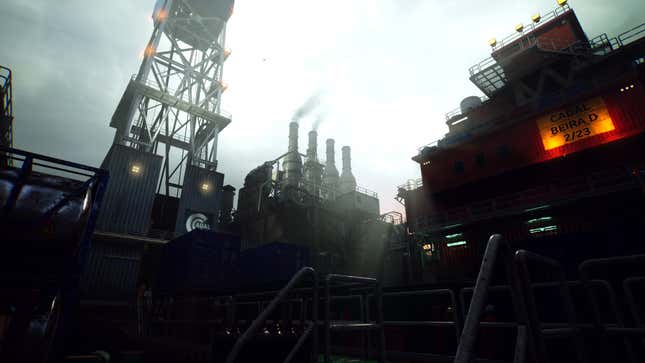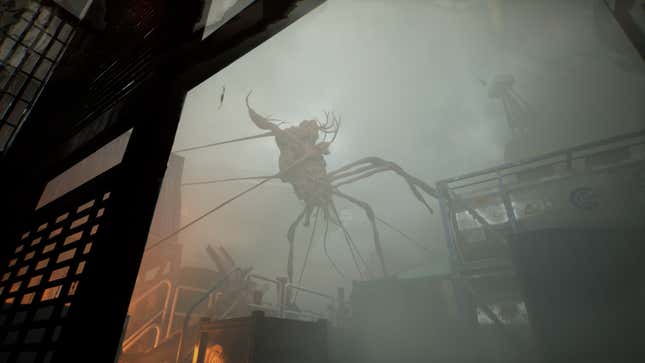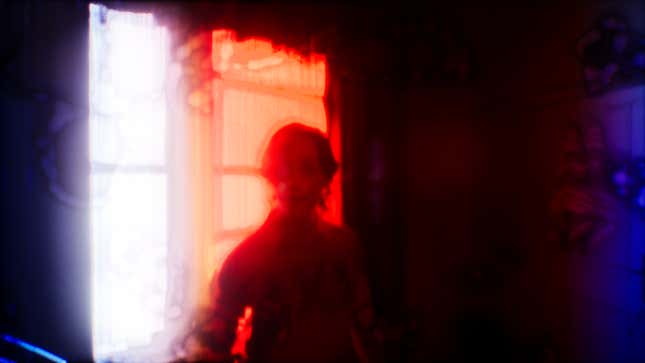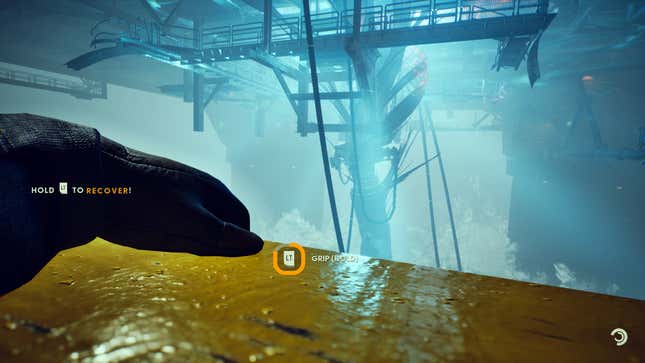As I peer out from a ventilation shaft to catch sight of the unspeakable horror in search of me, I prepare to toss a wrench I lifted from the ground in the desperate hope of distracting it. I step out of the shaft, throw it, and then immediately dart for the door. But I get the angle wrong and catch the lip of a beam just overhead. The monster turns and roars out that it has seen me with the contorted voice of someone I once knew. I have no means of dealing with this horrific creature and so I race to the nearest door. I make it out and seal the door behind me. I take a moment to catch my breath as I look around at the collapsing wreckage of this oil rig, this place of labor. The endless gray of the horizon looms forever into the distance; the ocean waves perpetually lap against the oil rig’s legs. Monstrous howls and screams emanate from the walls. Am I doomed to die here? Will I return home? Was it a mistake to come here?
Still Wakes The Deep is the latest from developer The Chinese Room, the team that brought us titles like Everybody’s Gone to the Rapture, Amnesia: A Machine For Pigs, and Dear Esther, and is currently at work on the sequel to 2004’s cult classic role-playing game, Vampire: The Masquerade – Bloodlines. This roughly six-hour experience proves to be a bit repetitive and tiresome where its platforming and puzzles are concerned, but its exceptional audio design delivers real chills, and it probes emotional depths that will haunt you long after the credits roll.
Read More: Troubled Vampire RPG Gets New Devs, Gameplay Changes, And 2024 Release
A horror “walking simulator” (a genre term I use lovingly) set in Scotland, Still Wakes The Deep follows the story of Caz McCleary and the crew of the Beira D oil rig as a series of unexpected, unexplainable, and horrific events besiege the rig and its crew. Caz finds himself on the Beira D not because he’s made a lifelong career out of being a roughneck, but as a way to lay low while some drama at home hopefully chills out. See, the police may want to have a little chat with our pal Caz after he found himself caught up in some bullshit he likely instigated. His bright idea is to not face the consequences of his actions and instead work a random gig on an oil rig way out on the ocean where the police aren’t likely to find him. It’s 1975, I guess you could get away with such things back then.

But Caz isn’t just leaving trouble behind, he’s also leaving his wife and daughters behind as well. His decision to flee problems back home, however, turns out to be a really bad move on his part as an otherwise normal day on the job gets turned upside down when the Beira D hits something on the ocean floor that unleashes monstrous growths and tendrils on the rig, ensnaring and transforming people into grotesque monsters. That Caz is now at risk of never seeing his family again is where I found the real horror of Still Wakes. Underneath the incomprehensible body horror, chases and hiding sequences, hellacious screams, and perilous journeying through a collapsing oil rig in the middle of nowhere, is the reality that all of this horror likely could be avoided. That’s what stuck with me the most: What harm do we bring on ourselves by running away from our problems and leaving those we love behind? What harm do we bring to others, especially those we love, by choosing to run? And running is something Caz will have to do a whole lot of in this game.

When it comes to the monsters of Still Wakes the Deep, the creepy masses of contorted flesh with long spindly arms that stomp around the place echoing out vocalizations of the humans they used to be, you can only throw objects to distract ‘em and, yup, run. There’s no combat or fighting in Still Wakes. You’ll spend your time walking, fiddling with oil rig equipment, ungracefully crawling under things, climbing over things, hiding from the monsters, and then running from them when they catch sight of you. Those monsters are indeed terrifying, especially as aural threats. Their hellacious screaming amidst the panic-inducing booms and bangs of these monsters thrashing around the metal halls of the Beira D is a delight and a terror, in all the best ways.
The game does an excellent job of instilling a direct and urgent flight response every time you encounter them. And without the option to fight, it works as an alternative survival horror experience to the many games in which you’re expected to make a stand and fight.
Unfortunately, Still Wakes the Deep’s puzzles and non-monster elements aren’t terribly engaging. These consist of climbing scenarios, the lightest of platforming challenges, and tasks to go somewhere, collect a thing, flip a switch, and so on, all in the hopes of finding a way off the unfolding nightmare all around you. There is great attention to detail in the models and textures of the rig. The Beira D is arguably a character unto itself and absorbing the aesthetic of this colossal rig as you navigate these spaces does sell the setting, but it’s not enough to keep the puzzles and traversal from growing routine.

Still Wakes also struggles to deliver on its initial setup. From the opening, you’re hit with a strong sense of the crew and its struggles, as well as some of what’s going on back home. The first antagonist you face, in fact, isn’t an unnamed monster, but rather your asshole boss who thinks he knows how to run machinery he’s nowhere near equipped to understand or maintain, berating and browbeating his employees with vicious disregard for who they are as people. NPCs talk of unionization and “industrial action” as solutions to their problems, but those plans get cut short when the threats surface from the ocean depths.
There’s but a glimpse of this interesting, and all too-relatable, dynamic in a way that I had hoped would remain central to the horror themes, but it ends up sidelined and forgotten. The same could be said of any notion of an environmental critique of oil drilling. It doesn’t feel like the act of deep sea drilling or the corporation’s reckless handling of its equipment and employees are directly connected to the horror that emerges. When the monsters show up, most of the game’s early contemplations of the consequences of profit over people fade into the periphery. You’re just focused on running for your life.

Through cryptic dreams and hallucinations, however, Caz’s abandonment of his family remains ever present. You’ll get told the story of what happened back home in brief, distorted flashbacks, and in some ways it’s up to you to piece together the emotional struggle. But like with its political themes, I found myself wanting more of this material integrated into the horror experience.
However, I can’t deny that I’ve been thinking about Caz’s little predicament long after the credits rolled. I find myself ruminating on the implications of the game’s ending, and that theme of running, of not daring to face the things that scare us, of thinking we individually know what’s best instead of coming together with someone, perhaps someone we love, to find solutions for difficult problems. Why do we sometimes think that we personally know best and are unwilling to listen to those who mean the most to us? How can we be better to those we love when things seem impossible otherwise?
I find myself rather grateful to be facing those questions. And that, I think, is where Still Wakes succeeded the most with me. Where have I done the same, like Caz, choosing to ignore people I love? How I can I metaphorically avoid fucking off to an oil rig where who-the-hell-knows-what can happen? How can I not make situations worse than they are?

Still Wakes the Deep isn’t the most riveting interactive journey. The monsters are easy to hide from (though plenty scary), and the puzzles and platforming quickly come to feel tired. But Still Wakes does deal with compelling emotional material that rewards you for your time spent with it. It’s the kind of game I’d like to play again and see what new things I get out of it. But it’s also a testament to why I like this genre, the poorly-named “walking simulator,” so much. When I’m not focused on the reactive challenges of a more fast-paced game that demands constant input response, I’m instead offered the challenge of navigating the puzzles of my own thoughts. You know, where the real horror and dread lies.
.


